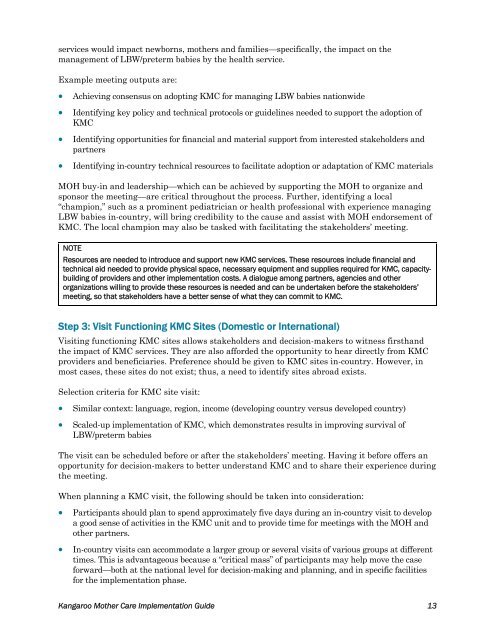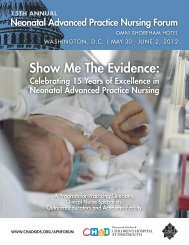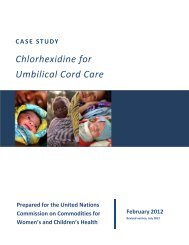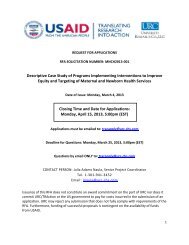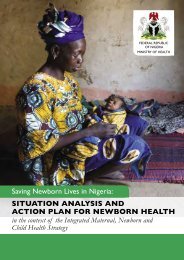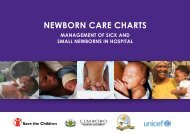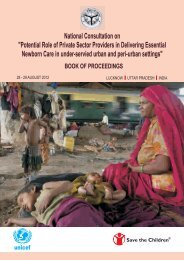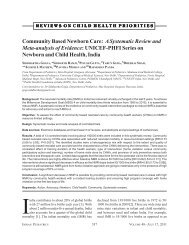Kangaroo Mother Care - MCHIP
Kangaroo Mother Care - MCHIP
Kangaroo Mother Care - MCHIP
Create successful ePaper yourself
Turn your PDF publications into a flip-book with our unique Google optimized e-Paper software.
services would impact newborns, mothers and families—specifically, the impact on the<br />
management of LBW/preterm babies by the health service.<br />
Example meeting outputs are:<br />
<br />
<br />
<br />
<br />
Achieving consensus on adopting KMC for managing LBW babies nationwide<br />
Identifying key policy and technical protocols or guidelines needed to support the adoption of<br />
KMC<br />
Identifying opportunities for financial and material support from interested stakeholders and<br />
partners<br />
Identifying in-country technical resources to facilitate adoption or adaptation of KMC materials<br />
MOH buy-in and leadership—which can be achieved by supporting the MOH to organize and<br />
sponsor the meeting—are critical throughout the process. Further, identifying a local<br />
“champion,” such as a prominent pediatrician or health professional with experience managing<br />
LBW babies in-country, will bring credibility to the cause and assist with MOH endorsement of<br />
KMC. The local champion may also be tasked with facilitating the stakeholders’ meeting.<br />
NOTE<br />
Resources are needed to introduce and support new KMC services. These resources include financial and<br />
technical aid needed to provide physical space, necessary equipment and supplies required for KMC, capacitybuilding<br />
of providers and other implementation costs. A dialogue among partners, agencies and other<br />
organizations willing to provide these resources is needed and can be undertaken before the stakeholders’<br />
meeting, so that stakeholders have a better sense of what they can commit to KMC.<br />
Step 3: Visit Functioning KMC Sites (Domestic or International)<br />
Visiting functioning KMC sites allows stakeholders and decision-makers to witness firsthand<br />
the impact of KMC services. They are also afforded the opportunity to hear directly from KMC<br />
providers and beneficiaries. Preference should be given to KMC sites in-country. However, in<br />
most cases, these sites do not exist; thus, a need to identify sites abroad exists.<br />
Selection criteria for KMC site visit:<br />
<br />
<br />
Similar context: language, region, income (developing country versus developed country)<br />
Scaled-up implementation of KMC, which demonstrates results in improving survival of<br />
LBW/preterm babies<br />
The visit can be scheduled before or after the stakeholders’ meeting. Having it before offers an<br />
opportunity for decision-makers to better understand KMC and to share their experience during<br />
the meeting.<br />
When planning a KMC visit, the following should be taken into consideration:<br />
<br />
<br />
Participants should plan to spend approximately five days during an in-country visit to develop<br />
a good sense of activities in the KMC unit and to provide time for meetings with the MOH and<br />
other partners.<br />
In-country visits can accommodate a larger group or several visits of various groups at different<br />
times. This is advantageous because a “critical mass” of participants may help move the case<br />
forward—both at the national level for decision-making and planning, and in specific facilities<br />
for the implementation phase.<br />
<strong>Kangaroo</strong> <strong>Mother</strong> <strong>Care</strong> Implementation Guide 13


